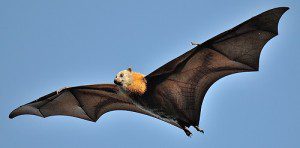
Campbelltown councillors got into a stink over what to do with a bat colony that set up camp at Macquarie Fields about eight years ago.
At council’s monthly meeting last night, the deputy mayor, Ted Rowell, reminded councillors that there could be as many as 5,000 grey headed flying fox – to give them their correct title – and “relocating’’ them would be as easy as “herding cats’’.
Cr Fred Borg said he just wanted them moved away from human beings, because, as Cr Bob Thompson said, “these flying foxes stink’’.
Cr Thompson said the stink was particularly bad near Alexander Crescent, which is close to the Macquarie Fields railway station.
The bat camp is actually nearer residents of Myee Road and Waratah Crescent, according to a report tabled at last night’s meeting, which said it may be home to almost 6,000 bats.
And none of the councillors mentioned it, but the report said “flying foxes are highly intelligent animals that are part of a complex and interdependent natural system.’’
The debate was caused by a request for action from Councillor Anoulack Chanthivong, who was not present at last night’s meeting.
Cr Chanthivong, who on March 28 was elected the Member for Macquarie Fields, told council that while campaigning for office one of the problems a lot of people had asked him to do something about was the stink produced by the flying foxes.
Council’s Environmental Planning Section has received seven complaints about the camp over noise, odour, droppings, potential water quality impacts, impacts on the recreational use of the reserve and the possible transmission of diseases commonly associated with flying-foxes such as Hendra Virus and Lyssavirus, the report said.
But it wasn’t the bats’ toilet habits which caused the smell issue, the report pointed out.
[social_quote duplicate=”no” align=”default”]“The odour comes from a scent that the males secrete from their glands when they are competing with each other for females and roosting sites,’’ the report said.[/social_quote]
“Young flying foxes also emit a scent which enables their mothers to locate them.’’
The report said of the bats: “As long range pollinators, they are critical to the survival of valuable forests and commercially important hardwood and rainforest species.’’
Also according to the same report, the bats have been forced to set up camp near homes because of human activity.
And because their numbers are decreasing, the bats are listed as a “vulnerable’’ species under both the NSW Threatened Species Conservation (TSC) Act 1995 and the Commonwealth Environment Protection Biodiversity Conservation (EPBC) Act 1999.
Councillor Paul Hawker suggested a regional solution through MACROC, with all three Macarthur councils working together.
[social_quote duplicate=”no” align=”default”]But then it was pointed out that even if a way was found to “herd’’ the flying foxes out of their current location, this would only result in relocating the problem to another part of the Macarthur region and thus be no solution at all.[/social_quote]
When the debate was finally exhausted, council decided to ask the Federal and State governments for help, and if that’s unsuccessful consider going on its own to prepare a “management plan’’ for the bats.
The report said such a management plan would cost between $45,000 to $55,000.
